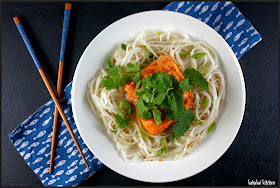Lucky for us, we are not the famous chefs of Europe and a killer isn't out to bake us to death in an oven, press us like a duck or drown us with lobsters as in the movie "Who Is Killing the Great Chefs of Europe?"-- our Food 'N Flix November pick, hosted by Evelyne at Cheap Ethnic Eats. In the movie, Jacqueline Bisset stars as Natasha O'Brien, a well-known pastry chef, who is brought to London to help prepare a dinner for The Queen by food snob, culinary magazine publisher and much-overweight culinary critic Maximillian "Max" Vandeveer (Robert Morely). Natasha's ex-husband, Robby (George Segal) is in Europe looking for a famous chef to oversee the newest idea in his stable of fast food chain restaurants--cooking omelets for the masses, and the two are pushed back together when famous chefs start dying and it looks like Natasha might be next.
I actually remember seeing this 1978 comedy-mystery film when it came out at the old Joy Cinema in Tigard, Oregon. I was in Junior High and back then, it was the days when theaters had one screen and two features playing--so we pretty much saw everything that was showing. It was well before my foodie interests and I don't remember being particularly impressed with it at the time. Flash forward to watching it today, and it didn't impress me any more ;-) as it is a bit of a silly, over-acted film. But, there is a bit of kitschy late 70's charm to it and plenty of rich and decadent food so, although not what I would call a film classic, it was still fun to revisit.
For my dish inspired by the film, I went with something that Max Vandeveer would never put in the pages of his magazine Epicurious but, might have secretly enjoyed--a decadent peanut butter dessert in a jar. At the beginning of the film, Max fires a receptionist and condescendingly states that he once "found a jar of peanut butter in her desk!" (Oh the horror!) ;-) It got me to thinking about peanut butter and jars and then, a great little cook book I am in the process of reviewing called "Vegan Desserts in Jars: Adorably Delicious Pies, Cakes, Puddings and Much More" by Kris Holechek Peters. I will be doing a more thorough review of this book soon (so far I am loving making little jars full of yummy desserts). Since I am much more fond of peanut butter than Max Vandeveer appears to be--especially when it is combined with chocolate, the Peanut Butter Cream Cups were one of the first recipes in the book that I tabbed to make and I thought that they would be a good fit for the movie
Vegan Desserts in Jars says, "These lovely no-bake cups come together quickly with basic ingredients and can be made well in advance. The creamy peanut butter custard gives way to a rich chocolate bottom. They are creamy and decadent without being overly rich--perfect with a cup of coffee of tea."
Peanut Butter Cream Cups
Vegan Desserts in Jars by Kris Holechek Peters
(Makes 6 Servings)
1/4 cup non-dairy semisweet chocolate chips
1 tsp non dairy margarine or coconut oil (see note)
3 Tbsp nondairy milk of choice
1 (12.3-oz) package of silken tofu
1/3 cup natural creamy peanut butter (I added 1/2 cup)
1/2 cup powdered sugar, or to taste
1/2 tsp vanilla extract
non-dairy chocolate chips and/or salted peanuts, for garnish (optional)
Set out 6 4-oz canning jars. In a small microwave safe bowl, melt the chocolate chips, margarine or coconut oil, and milk in the microwave in 10 second increments and stirring until smooth. Divide the chocolate mixture among the jars, coating the bottoms (About 1 Tbsp per jar).
In a food processor or blender, combine the tofu and peanut butter, scraping down the sides as needed, until smooth. Add the powdered sugar and vanilla, staring with 1/2 cup sugar and adding more if needed, until you reach your desired sweetness.
Divide the peanut butter mousse among the jars (about 1/3 cup per jar). If desired, top with additional chocolate chips or peanuts to garnish, then screw on the lids. Refrigerate for at least 30 minutes before serving. These keep in the fridge up to 4 days.
Cooks Note: If you use the coconut oil, the chocolate will get firmer in the fridge the longer it chills. If you want to soften, just let the pudding come to room temperature for a few minutes before serving.
Notes/Results: These are a fun little treat! The silken tofu blends with the creamy peanut butter to make a smooth and fluffy pudding and tastes delicious when mixed with the thick pool of chocolate at the bottom. My jars were larger than four ounces, so I just made 4 of them instead of six. My layering was a bit messy so when making them again I would let the chocolate layer set up for maybe 15-20 minutes in the fridge before layering the cream mixture on top. Otherwise, they were great and I am sure I will make them again.
Thanks to Evelyne for hosting this round! (And for the link to watch this somewhat hard to find film!) If you missed this month's Food 'N Flix deadline and you love food, films and foodie films, join us in December for one of my favorite holiday films, Elf--hosted over at The Law Student's Cookbook.
















































